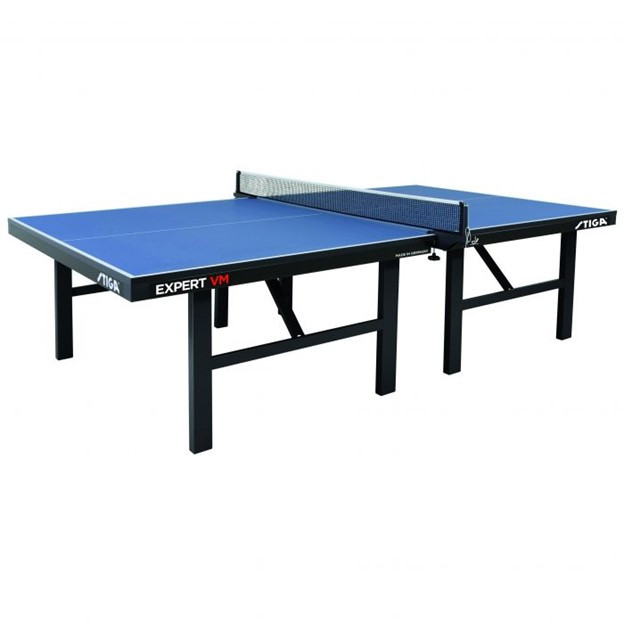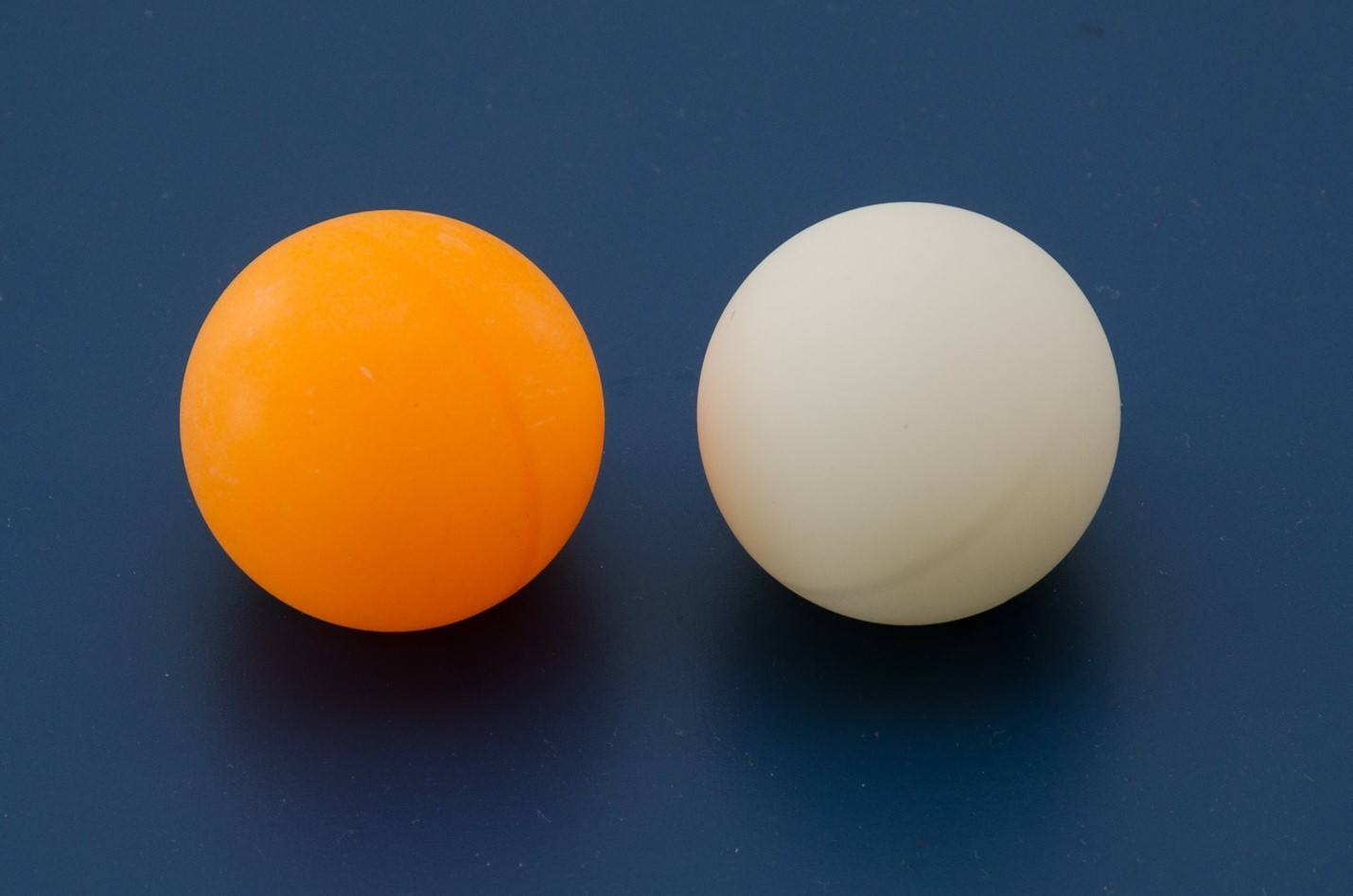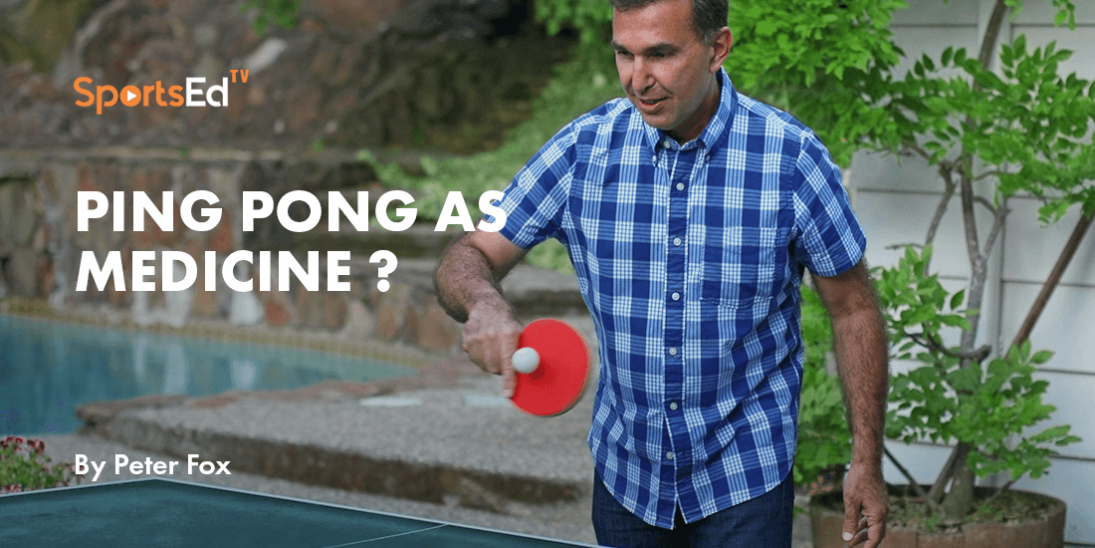Table Tennis
Welcome and thanks for visiting...

The Rules of Table Tennis
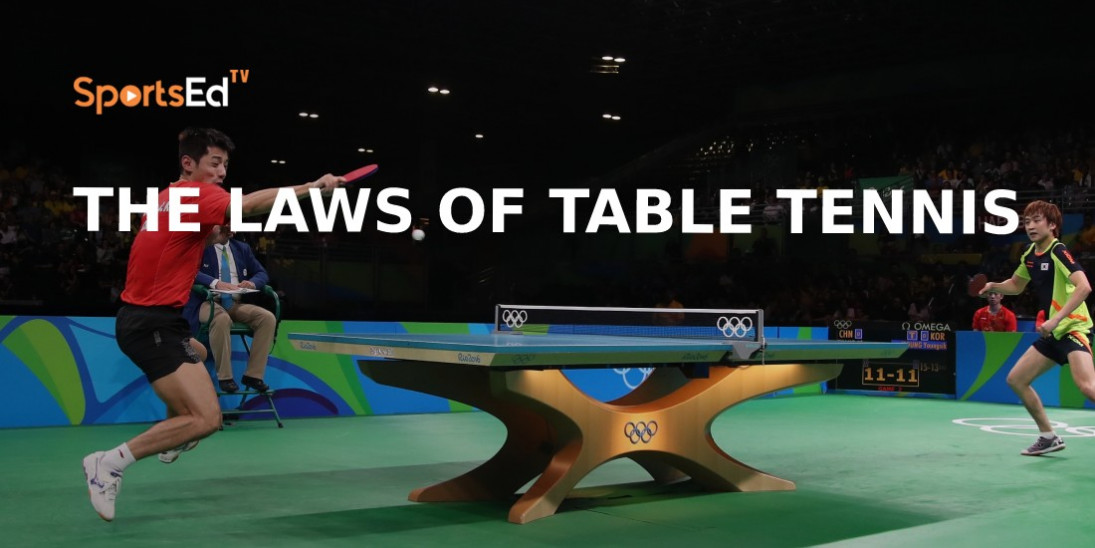
Here are the rules of table tennis from the International Table Tennis Federation
What is Table Tennis?
Table tennis, also known as ping pong, is a sport that involves two or four players hitting a small, lightweight ball back and forth over a table that is divided by a net. The objective of the game is to hit the ball in such a way that the opponent is unable to return it, scoring a point in the process. Players use small paddles, also known as rackets, to hit the ball, which is usually made of celluloid or similar plastic material. Table tennis can be played in both singles and doubles formats, and is a popular sport played both recreationally and competitively around the world.
The Table Tennis Table
The upper surface of the table, known as the playing surface, shall be rectangular, 2.74m long, and 1.525m wide, and shall lie in a horizontal plane 76cm above the floor. 2.1.2 The playing surface shall not include the vertical sides of the tabletop. 2.1.3 The playing surface may be of any material and shall yield a uniform bounce of about 23cm when a standard ball is dropped onto it from a height of 30cm.
The playing surface shall be uniformly dark colored and matt, but with a white side line, 2cm wide, along each 2.74m edge and a white end line, 2cm wide, along each 1.525m edge. 2.1.5 The playing surface shall be divided into 2 equal courts by a vertical net running parallel to the end lines and shall be continuous over the whole area of each court.
For doubles, each court shall be divided into 2 equal half-courts by a white center line, 3mm wide, running parallel with the side lines; the center line shall be regarded as part of each right half-court.
The Net Assembly
The net assembly shall consist of the net, its suspension, and the supporting posts, including the clamps attaching them to the table.
The net shall be suspended by a cord attached at each end to an upright post 15.25cm high, the outside limits of the post being 15.25cm outside the sideline. The top of the net, along its whole length, shall be 15.25cm above the playing surface. The bottom of the net, along its whole length, shall be as close as possible to the playing surface and the ends of the net shall be attached to the supporting posts from top to bottom.
Table Tennis Ball
The ball shall be spherical, with a diameter of 40mm. The ball shall weigh 2.7g. The ball shall be made of celluloid or similar plastics material and shall be white or orange, and matt
Table Tennis Racket
The racket may be of any size, shape, or weight but the blade shall be flat and rigid. At least 85% of the blade by thickness shall be of natural wood; an adhesive layer within the blade may be reinforced with fibrous material such as carbon fiber, glass fiber, or compressed paper, but shall not be thicker than 7.5% of the total thickness or 0.35mm, whichever is the smaller. A side of the blade used for striking the ball shall be covered with either ordinary pimpled rubber, with pimples outwards having a total thickness including adhesive of not more than 2.0mm, or sandwich rubber, with pimples inwards or outwards, having a total thickness including adhesive of not more than 4.0mm. Ordinary pimpled rubber is a single layer of non-cellular rubber, natural or synthetic, with pimples evenly distributed over its surface at a density of not less than 10 per cm² and not more than 30 per cm. Sandwich rubber is a single layer of cellular rubber covered with a single outer layer of ordinary pimpled rubber, the thickness of the pimpled rubber not being more than 2.0mm. The covering material shall extend up to but not beyond the limits of the blade, except that the part nearest the handle and gripped by the fingers may be left uncovered or covered with any material. The blade, any layer within the blade and any layer of covering material or adhesive on a side used for striking the ball shall be continuous and of even thickness. The surface of the covering material on a side of the blade, or of a side of the blade if it is left uncovered, shall be matt, bright red on one side and black on the other. With effect 1st October 2021, the surface of the covering material on a side of the blade, or of a side of the blade if it is left uncovered, shall be matt, black on one side, and of a bright color clearly distinguishable from black and from the color of the ball on the other. The racket covering shall be used without any physical, chemical or other treatment. Slight deviations from continuity of surface or uniformity of color due to accidental damage or wear may be allowed provided that they do not significantly change the characteristics of the surface.
Before the start of a match and whenever he or she changes his or her racket during a match a player shall show his or her opponent and the umpire the racket he or she is about to use and shall allow them to examine it.
Table Tennis - Ping Pong Definitions
A rally is the period during which the ball is in play.
The ball is in play from the last moment at which it is stationary on the palm of the free hand before being intentionally projected in service until the rally is decided as a let or a point. A let is a rally of which the result is not scored. A point is a rally of which the result is scored.
The racket hand is the hand carrying the racket. The free hand is the hand not carrying the racket; the free arm is the arm of the free hand. A player strikes the ball if he or she touches it in play with his or her racket, held in the hand, or with his or her racket hand below the wrist.
A player obstructs the ball if he or she, or anything he or she wears or carries, touches it in play when it is above or traveling towards the playing surface, not having touched his or her court since last being struck by his or her opponent.
The server is the player due to strike the ball first in a rally. The receiver is the player due to strike the ball second in a rally. The umpire is the person appointed to control a match. The assistant umpire is the person appointed to assist the umpire with certain decisions.
Anything that a player wears or carries includes anything that he or she was wearing or carrying, other than the ball, at the start of the rally.
The end line shall be regarded as extending indefinitely in both directions.
The Table Tennis Serve
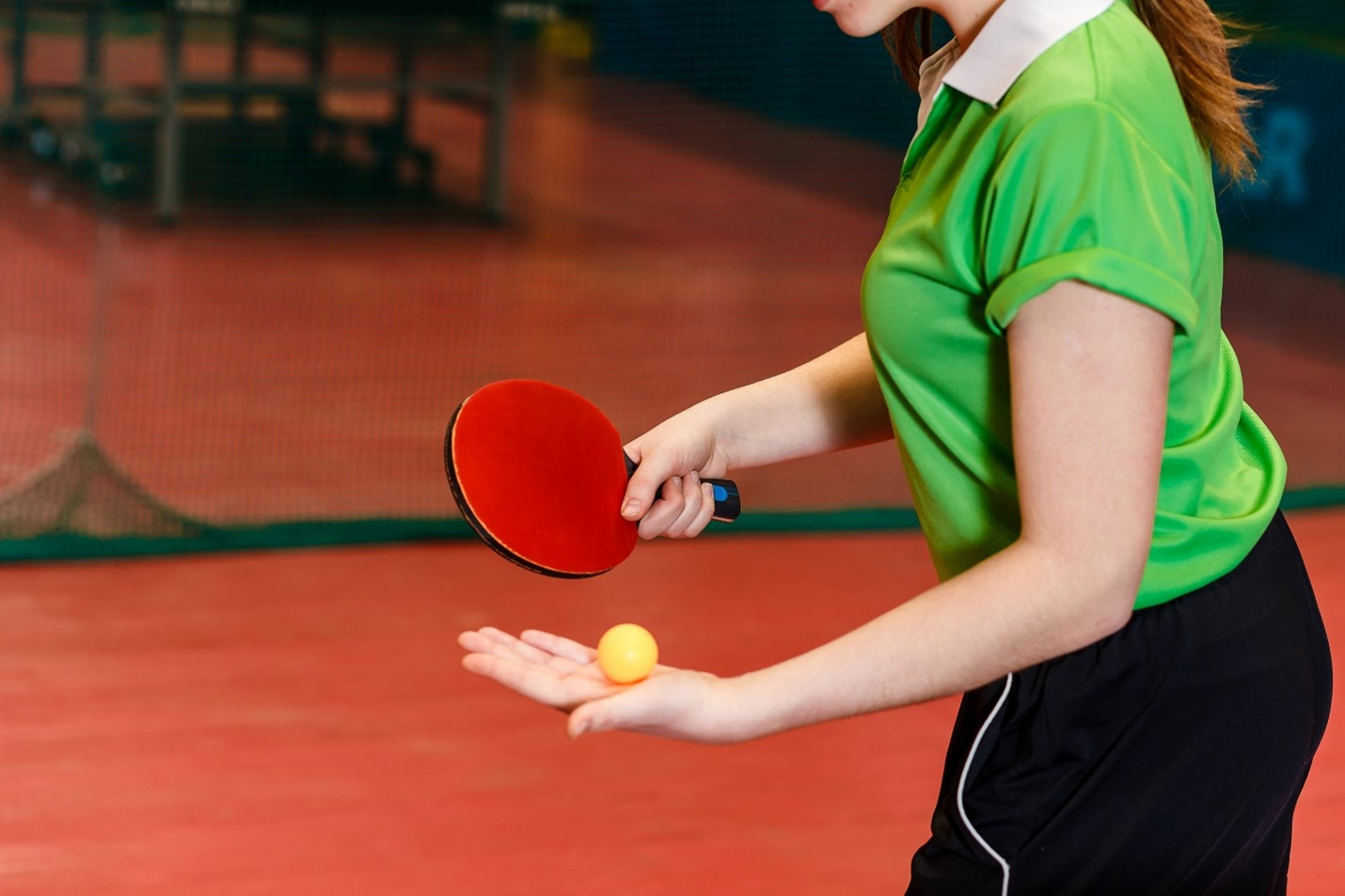
Service shall start with the ball resting freely on the open palm of the server's stationary free hand. The server shall then project the ball vertically upwards, without imparting spin, so that it rises at least 16cm after leaving the palm of the free hand and then falls without touching anything before being struck. As the ball is falling the server shall strike it so that it touches first his or her court and then directly touches the receiver's court.
In doubles, the ball shall touch successively the right half-court of the server and receiver. From the start of service, until it is struck, the ball shall be above the level of the playing surface and behind the server's end line, and it shall not be hidden from the receiver by the server or his or her doubles partner or by anything they wear or carry. As soon as the ball has been projected, the server’s free arm and hand shall be removed from the space between the ball and the net. The space between the ball and the net is defined by the ball, the net, and its indefinite upward extension. It is the responsibility of the player to serve so that the umpire or the assistant umpire can be satisfied that he or she complies with the requirements of the Laws, and either may decide that a service is incorrect. If either the umpire or the assistant umpire is not sure about the legality of a service he or she may, on the first occasion in a match, interrupt play and warn the server; but any subsequent service by that player or his or her doubles partner which is not clearly legal shall be considered incorrect. Exceptionally, the umpire may relax the requirements for a correct service where he or she is satisfied that compliance is prevented by physical disability.
The Return
The ball, having been served or returned, shall be struck so that it touches the opponent's court, either directly or after touching the net assembly.
The Order of Play
In singles, the server shall first make a service, the receiver shall then make a return and thereafter server and receiver alternately shall each make a return. In doubles, the server shall first make a service, the receiver shall then make a return, the partner of the server shall then make a return, the partner of the receiver shall then make a return and thereafter each player in turn in that sequence shall make a return. In doubles, when at least one player of a pair is in a wheelchair due to a physical disability, the server shall first make a service, the receiver shall then make a return but thereafter either player of the disabled pair may make returns.
Table Tennis Let
The rally shall be a let: if in service the ball touches the net assembly, provided the service is otherwise correct or the ball is obstructed by the receiver or his or her partner; if the service is delivered when the receiving player or pair is not ready, provided that neither the receiver nor his or her partner attempts to strike the ball; if failure to make a service or a return or otherwise to comply with the Laws is due to a disturbance outside the control of the player; if play is interrupted by the umpire or assistant umpire; if the receiver is in wheelchair owing to a physical disability and in service the ball, provided that the service is otherwise correct, after touching the receiver’s court returns in the direction of the net; comes to rest on the receiver's court; in singles leaves the receiver’s court after touching it by either of its sidelines. Play may be interrupted to correct an error in the order of serving, receiving, or ends; to introduce the expedited system; to warn or penalize a player or adviser; because the conditions of play are disturbed in a way that could affect the outcome of the rally.
A Point
Unless the rally is a let, a player shall score a point if an opponent fails to make a correct service; if an opponent fails to make a correct return; if, after he or she has made a service or a return, the ball touches anything other than the net assembly before being struck by an opponent; if the ball passes over his or her court or beyond his or her end line without touching his or her court, after being struck by an opponent; if the ball, after being struck by an opponent, passes through the net or between the net and the net post or between the net and playing surface; if an opponent obstructs the ball; if an opponent deliberately strikes the ball more than once in succession; if an opponent strikes the ball with a side of the racket blade whose surface does not comply with the requirements and if an opponent, or anything an opponent wears or carries, moves the playing surface; if an opponent, or anything an opponent wears or carries, touches the net assembly; if an opponent's free hand touches the playing surface; if a doubles opponent strikes the ball out of the sequence established by the first server and first receiver; as provided under the expedite system; if both players or pairs are in a wheelchair due to a physical disability and his or her opponent does not maintain a minimum contact with the seat or cushion(s), with the back of the thigh, when the ball is struck; his or her opponent touches the table with either hand before striking the ball; his or her opponent’s footrest or foot touches the floor during play. if, where an opposing doubles pair includes at least one player in a wheelchair, any part of the wheelchair or a foot of a standing player crosses an imaginary extension of the center line of the table.
Table Tennis Game
A game shall be won by the player or pair first scoring 11 points unless both players or pairs score 10 points when the game shall be won by the first player or pair subsequently gaining a lead of 2 points. A match shall consist of the best of any odd number of games.
The Order of Serving, Receiving and Ends
The right to choose the initial order of serving, receiving and ends shall be decided by lot and the winner may choose to serve or to receive first or to start at a particular end. When one player or pair has chosen to serve or to receive first or to start at a particular end, the other player or pair shall have the other choice. After every 2 points have been scored the receiving player or pair shall become the serving player or pair and so on until the end of the game unless both players or pairs score 10 points or the expedite system is in operation when the sequences of serving and receiving shall be the same but each player shall serve for only 1 point in turn. In each game of a doubles match, the pair having the right to serve first shall choose which of them will do so and in the first game of a match the receiving pair shall decide which of them will receive first; in subsequent games of the match, the first server having been chosen, the first receiver shall be the player who served to him or her in the preceding game. In doubles, at each change of service, the previous receiver shall become the server and the partner of the previous server shall become the receiver. The player or pair serving first in a game shall receive first in the next game of the match and in the last possible game of doubles match the pair due to receive next shall change their order of receiving when the first pair scores 5 points. The player or pair starting at one end in a game shall start at the other end in the next game of the match and in the last possible game of a match the players or pairs shall change ends when the first player or pair scores 5 points.
Out of Order of Serving, Receiving or Ends
If a player serves or receives out of turn, play shall be interrupted by the umpire as soon as the error is discovered and shall resume with those players serving and receiving who should be server and receiver respectively at the score that has been reached, according to the sequence established at the beginning of the match and, in doubles, to the order of serving chosen by the pair having the right to serve first in the game during which the error is discovered If the players have not changed ends when they should have done so, play shall be interrupted by the umpire as soon as the error is discovered and shall resume with the players at the ends at which they should be at the score that has been reached, according to the sequence established at the beginning of the match. In any circumstances, all points scored before the discovery of an error shall be reckoned.
The Expedite System
The expedite system shall come into operation after 10 minutes’ play in a game or at any time when requested by both players or pairs. The expedite system shall not be introduced in a game if at least 18 points have been scored. If the ball is in play when the time limit is reached and the expedite system is due to come into operation, play shall be interrupted by the umpire and shall resume with service by the player who served in the rally that was interrupted; if the ball is not in play when the expedite system comes into operation, play shall resume with service by the player who received in the immediately preceding rally. Thereafter, each player shall serve for 1 point in turn until the end of the game, and if the receiving player or pair makes 13 correct returns in a rally the receiver shall score a point. The introduction of the expedite system shall not alter the order of serving and receiving in the match. Once introduced, the expedite system shall remain in operation until the end of the match.
Source:

